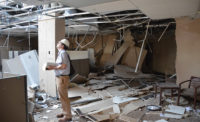
Related Article:
Fancy Footwork to Create PAC NYC’s Deceptively Simple Cube
Back to:
25 Top Newsmakers
Music + chess + rowing + sculpture + philosophy + math = the power of phenomena over form.
Music’s discipline of practice and performance. Chess’ strategies. Rowing’s relentless determination. Sculpture’s thought before action. Philosophy’s rigor of crafting reasoned arguments. Math’s balancing of equations.
These are the core influences that drive the cerebral architecture of Joshua Ramus, founding principal of REX and design architect for the Perelman Performing Arts Center at Manhattan’s World Trade Center.
The eight-story 160-ft-square cube, open since September, is a subdued backdrop to the 9/11 Memorial’s reflecting pools. It also is the manifestation of Ramus’ client-centered design philosophy—phenomena over form. The facade is “a great example,” says Ramus. “We started with a [client] directive to not see activity on the inside because of the memorial but to provide a building that would be alive at night.”
That led to the theater’s novel translucent-marble cladding. It is opaque by day, but, lit from within, it glows at night. “We presented an intelligently resolved system,” Ramus says. “We didn’t discuss beauty … though hopefully we achieve things that are beautiful,” while delivering on client needs.
Unlike many architects, REX has no preconceived aesthetic, says Jay Taylor, senior principal-retired of Magnusson Klemencic Associates, the theater’s structural engineer.
“Most architects simply say, ‘here’s what the building looks like, make it stand up,’” says Taylor, who has worked with Ramus for 25 years. “Josh says, ‘here’s our vision, tell me the structural constraints and challenges and describe ways to resolve them.’” The result is the “seamless integration of structure and architecture,” says Taylor, which is a rarity.
Ramus, 54, has long been disciplined and patient. As a youth in North Carolina and metro Seattle, he practiced horn three to four hours a day. And he played chess by snail mail with his grandfather in San Diego—one move per letter.

Ramus’ translucent marble facade on Perelman provides an opaque backdrop to the 9/11 Memorial reflecting pools by day, but lit from within, it glows at night.
Photo by Scott Hilling/ENR
Dare to be Dumb
As a freshman at Yale University, Ramus dropped the horn when he became obsessed with rowing. In college, he studied philosophy and math, but a whale-bone sculpture course led him toward design. The summer before the start of his master’s in architecture at Harvard University, Ramus trained for the Olympics, in rowing. He says the sport helped him develop “relentless focus” and “dumb determination” critical to his work. Ramus likes to “dare to be dumb,” which he says takes courage. “It means looking at something with a child’s mind, going back to first principles and exploring solutions without the weight of convention,” he says, adding, “it gets harder to do that as I get older.”
Ramus says he also harnesses “the power of performance over form,” for it goes beyond the “tired schism between form and function and suggests that form, too, can perform” for a building’s occupants, much like a finely tuned instrument.
With its complex inner workings, Perelman is a tuned instrument. The theater project, led by Sciame Construction LLC, was likened to building three ships in a bottle because of the three reconfigurable performance halls, with movable walls and floors. The flexibility empowers the artists, says Ramus. But it boggled the building team, which had to integrate all the moving parts into a well-oiled theater machine that also would be acoustically isolated and vibration free.
Beyond flexibility and performance, REX designs for the possibility of adaptive reuse. The mindset and high standards made working with REX always “challenging, liberating and rewarding,” says Taylor. “I implemented lessons I learned from Josh on every project I did with other architects.”
All ENR 2023 Top 25 Newsmakers will be honored at the Award of Excellence Gala on April 11 in New York City.





Post a comment to this article
Report Abusive Comment